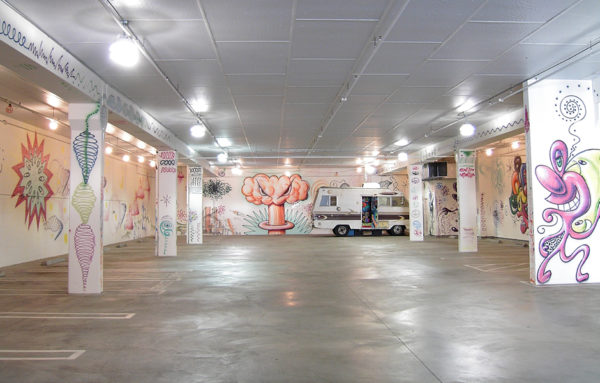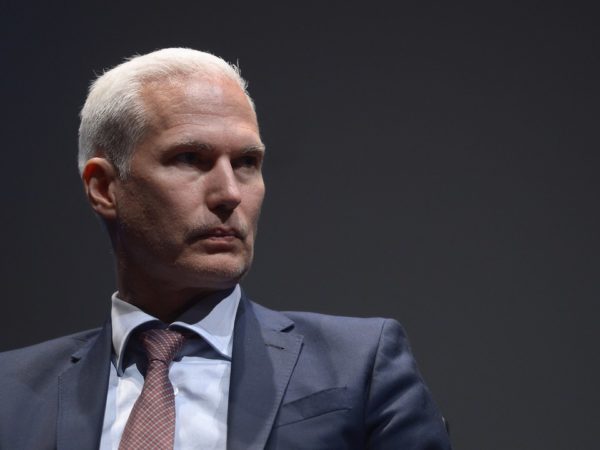JUDY CHICAGO IN PASADENA
“If men had babies, there would be thousands of images of the crowning,” Judy Chicago said in the early 1980s. The crowning is the moment the baby’s head begins to emerge from the birth canal. During a packed talk at the Women’s City Club of Pasadena in July, the artist looked back to the moment she realized how few images of childbirth there were in art, as if the topic were hidden and shameful. She thought it should have been celebrated, and thus was born the Birth Project, a textile-based project she worked on with a team of 150 women from 1980 to 1985.
Some 16 of the over 80 resulting works can currently be seen at the nearby Pasadena Museum of California Art in “Judy Chicago’s Birth Project: Born Again” (through Oct. 7). The images are electrifying and powerful, abstracted representations of women’s bodies and the birth process. The largest piece is the epic Prismacolor drawing, In the Beginning, at over 30 feet wide.
That afternoon Chicago also took the opportunity to talk about her art career, which unfolded largely in California, after she earned her MFA at UCLA, in 1964. “I had a really, really hard time during the ’60s and ’70s in the LA art scene,” she said. Still, “There was something else here that was irreplaceable—that was the spirit of self-invention.” At one point she had a studio in Pasadena, where “I worked 60 hours a week… I wanted to create a whole new type of art, a whole new way of art education.” During this period, she founded the Feminist Art Program at Cal State Fresno, and later, along with Miriam Schapiro, brought the program to Cal Arts. This led to the famous “Womanhouse,” and then “The Dinner Table.” For many years she made little money from her work and she is now finally finding success in the commercial realm. She has a gallery in New York, and next year Jeffrey Deitch, in his new LA digs, will be having a solo show for her.

PMCA’s parking garage with Kenny Scharf’s graffiti.
PMCA IS CLOSING, SADLY
This summer the PMCA has had one of its strongest exhibition slates ever—and then it’s closing. On June 13 the museum’s board decided to shutter up when these shows end. In addition to the “Birth Project” by Judy Chicago, there is another remarkable show in the back gallery focusing on the career and work of Grafton Tyler Brown (1841–1918), a painter, graphic designer and lithographer who is the only known African American in his profession in the western United States in the 19th century. He founded his lithography business in San Francisco in 1865, designing stock certificates, maps, sheet music and adverts. He later became a painter, selling landscape paintings. “Grafton Tyler Brown: Exploring California” includes some 45 of his paintings, prints and objects.
It is true that fundraising, as well as audience building, has always been difficult for small museums, unless they are set up with a wealthy endowment or benefactor. Even on weekends, I usually saw only a handful of people visiting the PMCA when there was not an opening or special event. It did have some terrific shows, and we shall miss it dearly. Founded in 2002 by Bob and Arlene Oltman, the museum focused on the art and artists of California—from traditional pleinair painters to Modernist designer Greta Magnusson Grossman and avant-garde sculptor Claire Falkenstein. Thank you, Bob and Arlene!

Klaus Biesenbach
MOCA SKINNY
After the debacle of firing Helen Molesworth as chief curator last March, Philippe Vergne did not see his contract as director of MoCA renewed. Or, as the press release in May told us, they “mutually elected not to renew Vergne’s contract when it expires March 2019.” In addition to the much-publicized firing of Molesworth, another demerit was probably his failure to meet the capital fundraising goal of $150 million set for him when he took the job.
At the end of July the MOCA Board announced their new choice—Klaus Biesenbach who served as director of MoMA PS1 and chief curator at large of MoMA since 2010. Biesenback is a respected veteran, having founded KW Institute for Contemporary Art (Kunst-Werke) in Berlin.
Artists on the MOCA board were closely involved in the selection, said artist and board member Catherine Opie. “It’s been crucial to me, Barbara Kruger, Mark Bradford and Mark Grotjahn, as some of the artists on the Board, that we’ve had a strong voice in the selection process… He comes to MOCA with a level of mutual trust with artists that is crucial for everything this museum does today, and that we hope it will be able to do in the future.”
COMINGS & GOINGS
Shoshana Wayne Gallery has announced its new location on Jefferson Boulevard in the West Adams area, with an opening in Fall/Winter 2018. The inaugural show will be “Gallery Portrait” which will look at the gallery’s three-decade history.
Susanne Vielmetter Los Angeles Projects is expanding her brick-and-mortar and joining the trend of moving to DTLA. Her new second space will be in an industrial building (an old tire company) on Sante Fe Avenue, near Wilding Cran gallery and the up-and-coming Soho House. We’re told it’s going to be 11,000-square-feet. Vielmetter inaugurates her new digs this fall with a group exhibition of her stellar roster of artists including Edgar Arceneaux, Kim Dingle and Charles Gaines.
And yes, Jeffrey Deitch is back—with a 15,000- square-foot gallery in Hollywood, on North Orange Drive, said to be opening this fall. It’s going to a pretty splashy opening, of course, featuring controversial Chinese artist and activist Ai Weiwei.
__________________________________________________________

Sabina Ott, photo by Anna Kunz
Sabina Ott 1955–2018
An appreciation by Mary Anna Pomonis
I met Sabina Ott for a class at Anderson Ranch in 1995, arriving a total mess from undergraduate school but still painting a lot.
Sabina focused on me, telling me I was great and that I didn’t need to be wasted to be interesting—she also told me I would be famous. In graduate school I sought her mentorship, and expected her role as my mentor not to end.

Mary Anna Pomonis with mentor Sabina Ott, photo by Cayce Lanham Zavaglia
After my husband left me, she brought soup and nursed me back to health. She told me to make a list of female artists whom I should befriend, because my big mistake was not in marrying a bad man, but by letting my whole network narrow down to one man.
I spoke to her for the last time a few weeks before her death. She was outside, looking at the trees and talking about the incredible beauty of life. We talked about the bridge from a particular life into a life outside our bodies. We ended by saying we loved each other. One of her last gifts to me was to tell me that an old perspective painting of mine connected to my new work. As soon as she said it, I envisioned the old painting drifting into the cosmos of the new work. She was a great teacher and a creative genius right to the end.
I reached out to a few women in the arts who knew Sabina, and asked them to share some memories that captured her spirit and personality:
“Sabina had a great wisdom that radiated through her work and her dealings with people. She knew how things worked, and how shitty things often could be, but she was not going to let it bother her. Watching her work over the years, since the mid-1990s, helped me understand what a visual artist actually does, and respect the intent and persistence.” —Chris Kraus
“She told me that a favorite teaching method was to announce to a student, ‘You are going to be a famous artist—and I am always right!’ She said the student would look at her doubtfully. Then she’d list the names of all of the famous artists that had been her students—and there are many! Then she’d exclaim again, ‘I am always right!’ And the thing is, she was.” —Dana Duff
“She frequently understood and revealed things about my work that I could not yet comprehend. She was also an important model for a young female artist. She was a talented working artist, she was intelligent, intuitive and not afraid.” —Diana Thater
“Sabina called me a genius all the time. Since modesty is a virtue in my cultural upbringing, I tended to brush it off. However, when a nominal phrase stays in circulation it begins to endow the beholder with real power.” —Shirley Tse



















0 Comments